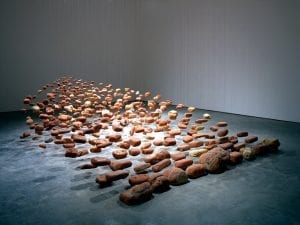Swirls of pink and red. Green and yellow voids. Fragments of wood, fracturing and splintering in front of our eyes. These are the works of self-taught sculptor Daniel Fuchs. Represented by Pashmin Art Consortia, he creates highly complicated and complex works from spruce wood – transforming plain panels into detailed filigree reliefs. The artist speaks to Aesthetica about the process, whilst explaining how he came to be inspired by natural materials.
Details of Daniel Fuchs, Creation, Spruce wood. 125cm H x 250cm W x 23cm D, 2018
A: What inspired you to become an artist?
DF: I grew up with a lot of art around me at an early age. My grandmother had worked in the Satiricum in Greiz, where the largest collection of copper engravings in the former GDR was kept. This also gave me access to many objects, sculptures and caricatures. I stayed there a lot and developed my painting skills there.
A: How did you start working with wood as a material? What is it that inspires you?
DF: Wood had a magical attraction to me. Some artists like metal or plastic – I like wood. It is warm and soft, has its edges and its structure – it is simply pure nature! I always wanted to do something with wood. You can, of course, become a carpenter, which is also a kind of art. But the idea of making art that you hang on the wall – that is put up to be looked at – was a great incentive for me. From my earliest childhood, I had a great drive to create something special without a practical purpose. Painting bored me, too many were doing that.

Daniel Fuchs, Creation, Spruce wood. 125cm H x 250cm W x 23cm D, 2018
A: There are vast varieties of wood. What is your preferred type to work with?
DF: I like the spruce because of its structure, grain and colouring. It is a light wood that can be coloured well. I couldn’t work so well with darker materials like tropical wood or mahogany. For me, the German spruce is the best for my artistic process: not too hard and not too soft.
A: How do you colour your pieces?
DF: I use pigments. They consist of small particles and are insoluble. They are the oldest art paints in the world. They were used for painting the famous terracotta armies of the emperors of China and ancient statues in Egypt.
Left: Detail of: Daniel Fuchs, Relationship Triptych (No.2), Spruce wood. 80cm H x 62cm W x 35cm D, 2019.
Right: Detail of: Daniel Fuchs, Fracture, Spruce wood. 130cm H x 75cm W x 13cm D, 2019
A: Do you have a favorite work?
DF: In my current exhibition there is a picture called Forces. It is a picture of a bark structure with moss growth. Some see a canyon with trees in it. Some see something completely different. The second is Desert. I particularly like the combination of water with a dry structure. I love these two works the most.
A: What do you hope viewers take away from your pieces?
DF: The main thing is that some emotion is aroused. If the viewer feels drawn to a work and emotions develop, then I am happy. That is the most important thing to me.
A: Who taught you the technical know-how and your filigree technique?
DF: I taught myself the technique. For 20 years, I had a workshop in which I turned and processed inlays. It was there I taught myself filigree work. I had to build myself a scroll saw. For this, you need the spiritual understanding and the will to create something.

Detail of: Daniel Fuchs, Fibonacci, Spruce wood. 115cm H x 215cm W x 30cm D, 2019
My work looks like it is created in one piece. In fact, I work into the high and low reliefs by breaking up a flat sheet of spruce into many pieces, similar to a puzzle. Then, I pull out each puzzle piece and move it to a different position. This is a complex process.
A: If you were no longer able to work with wood, which material or fabric would be an alternative?
DF: There is no alternative for me! I have a close connection to wood. If there was no more wood, then I could not exist.
A: Where would you like to present your art in future?
DF: Preferably in New York, London or Shanghai in the subway – 20 metres long, 3 metres high. Or, in another place where I can present a large work to a big audience.
A: How about your exhibitions in 2021?
DF: In 2021, my selected works will be exhibited by Pashmin Art Consortia at Hong Art Museum (14 May – 14 July 2021), Mark Rothko Museum (3 September – 17 October 2021) in Latvia and Beijing’s Archive Art Museum (15 October – 15 November 2021).
Find out more about the artist here. Visit Pashmin Art Consortia here.
All images © Pashmin Art Consortia
Lead image: Detail of: Daniel Fuchs, Bull-Head, Spruce wood. 50cm H x 60cm W x 50cm D, 2019.









